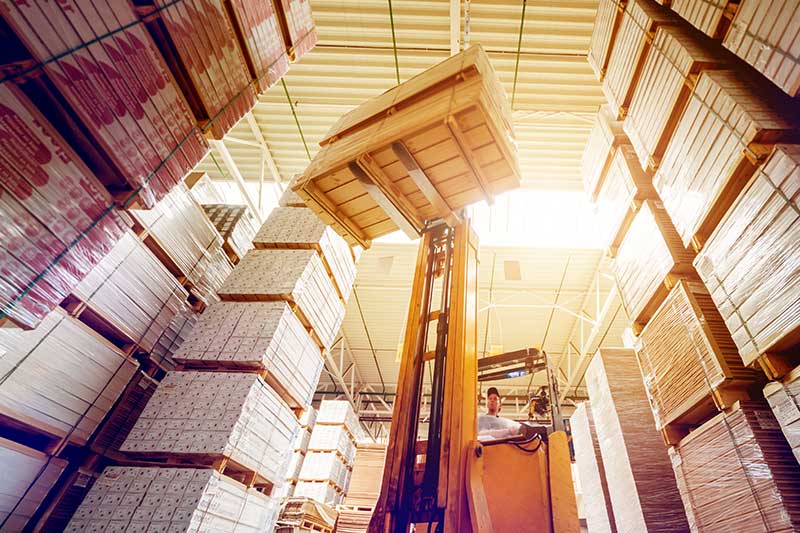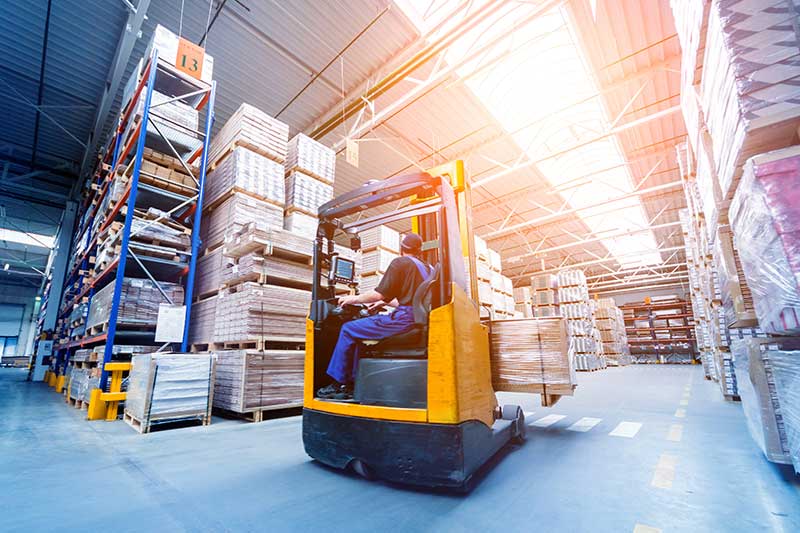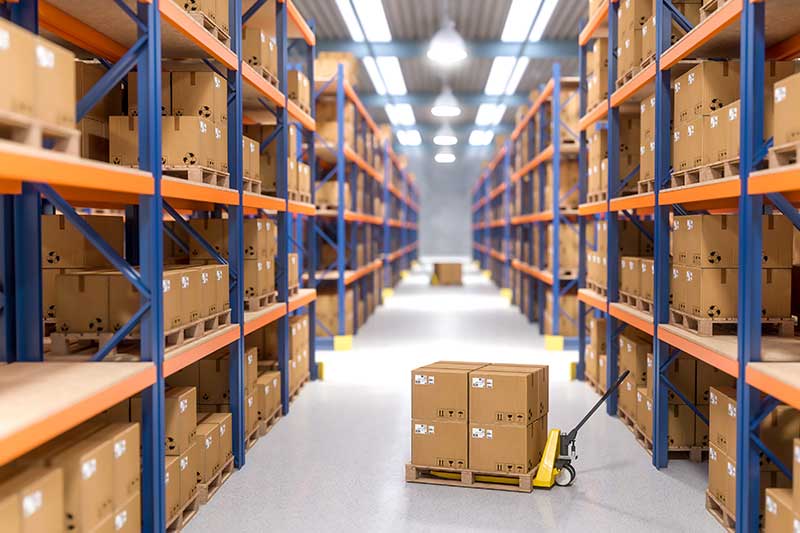Category: Warehouse
Top Tips To Enhance Warehouse And Inventory Management Efficiency
For a manufacturing company to succeed and improve its production capabilities, it needs to first manage its warehouse and inventory efficiently. In order to improve warehouse operations and manage inventory more efficiently, consider the following tips:
Implement an Automated Data System
The use of RFID (radio-frequency identification) systems, barcodes, or any other inventory tracking technology to manage goods in a warehouse can help reduce the risk of human error. When workers are tasked with collecting data manually, this can be risky and affect warehouse efficiencies. Failure to correctly note down the correct number or letter can be the difference in losing a lot of money.
By implementing automated data systems, business owners will be able to store up-to-date data with greater ease. Workers are also able to access the information instantly at any time. In addition, adopting an ERP system with a strong warehouse management system (WMS) module can help improve overall efficiency by suggesting the best methods and routes for picking or storing goods.
Organize Workstations
A well-arranged and organized warehouse makes it easy for workers to locate products, equipment, and tools. This helps to reduce human error and improve workplace safety as well. To organize a workstation, you need to adopt the 5s: sorting, setting in order, shinning, standardizing, and sustaining. This system helps to keep clutter at bay.
Lean Inventory
Adopting a lean inventory in manufacturing is important and the same concept applies to a warehouse as well. The basic rule to maintain a lean inventory by storing only what you need and nothing more. In addition, you can work toward reducing or possibly eliminating safety stocks and trying to get suppliers to deliver smaller quantities frequently.
Maximize Available Space
Instead of worrying on how to expand the footprint of your warehouse, think more on how to better maximize any available vertical space. Rather than incurring expansion costs, it is wiser to add tall storage units and invest in the right storage kits to be able to store more items in the same square footage. In addition, consider the type and variety of shelves you use. Different materials need different types of shelving. For example, if you store small things on pallet racks, you may end up wasting space and items can easily get misplaced. Consider using standardized bins to keep shelves orderly and neat.
Optimize Labor Efficiency
You can reduce travel time in your warehouse by storing high-volume items together near the front of the facility. Also, you can analyze your material usage and keep the items that are frequently used or sold near one another. This system not only eliminates picking delays, but also fastens operations resulting in more productivity.
Plan Ahead With Picking Procedures
Plan in advance with an efficient freight company on picking hours. This prevents last minute work and helps to eliminate the inconvenience of being short-handed during peak periods. Recognizing picking style patterns helps floor managers to direct pickers to the areas that require the most work.
Once you enhance your warehouse and inventory management efficiency, you are expected to achieve:
- Reduced error rates
- Increased productivity
- Improved order fulfillment
- Increased operational efficiency
- Minimized inventory holding costs
How To Enhance Item Stock Management In Your Warehouse
Running a retail or wholesale business entails the need to deal with stock on a day-to-day basis. When there are thousands of merchandises on hand, it is crucial to know how to manage all of them in an organized manner. How can you be assured that you have an efficient stock management system in your warehouse? Following the tips in here will do you a lot of help.
Manage Stocks Accordingly
Old stocks need to go first before newer items. This is especially so if you are selling goods that have expiry dates. If you want to make sure that you are handling all these items efficiently, you need to separate old merchandise from new ones. Using a warehouse management software will help if you have thousands of items in your warehouse. That way, you will be able to manage your stocks at a lesser amount of time.
Consider fast and slow-moving items in your inventory as well. You have to consider these when separating items accordingly. Fast-selling items will surely go first thus they should be stocked where they can be accessed easily. For your slow-moving items, on the other hand, it will be good to develop strategies on how to sell them fast too. This is aside from stocking them in an area where they can be kept for a longer time than usual.
Make Your Records Accurate
Your records are very important when managing a warehouse. You need to record what goes in and out of it, by updating your record books regularly. Make sure that all items are well accounted for at the time they get in and go out of your warehouse. You would never want the idea of losing profit just because you failed to record the goods that have already been out of your facility.
Make an Inventory Forecast
This can be one of the most difficult steps when handling your inventory, especially if your products fall into different categories. Forecasting involves determining the price of the item, thus making forecasting even more complicated. Using an inventory system is the solution to making forecasting a whole lot easier. There is a type of software that can help automate forecasts for easier inventory taking.
Assign a Barcode to Your Products
Barcodes do a lot of help in recording the flow of your inventory, as well as in speeding up the process of doing your inventory taking regularly. Barcode systems these days already include codes where they are easier to spot when you have bought an item. You just need a barcode scanner to access the printed barcode. From there, the product information will already be displayed on the computer screen.
Warehouse management can be a tough job, without the help of companies that are already experts on handling stock. Working with a logistics company can help save you from these tiresome processes. At STC Logistics, we have warehouse fulfillment measures that will work when it comes to managing stock piece by piece without much of a hassle. We have inventory management systems that are proven to work for any type of business.
How To Choose The Correct Warehouse Management System
Because 3PL (the abbreviation of third-party logistics) warehousing is constantly evolving, one’s operation may experience several changes over the years. That’s why growing 3PLs are recommended to employ a warehouse management system (WMS) that adapts and changes with their businesses. Because there is a wide range of warehouses operating in the logistics vertical today, there is an abundance of software to choose from. Before starting your search for the perfect WMS, it is important to first identify several key traits about your warehouse.
Understand Your Shipments
Does your business specialize in assembling and kitting; carton in/carton out; or pallet in/pallet out (cross-docking)? It is recommended that business owners choose a WMS technology that can automate existing workflows and enable hands-free shipping, packing, and picking. With the rise of e-commerce, achieving 100 percent order accuracy will be invaluable to your customers as you scale together.
Identify Products that Require Storage
Another step you can take is to identify all the types of products that are currently stored in the warehouse, as well as items that may be stored in the future. By gaining a clear picture on which type of warehouse you want to operate, the more specific you can be in the software selection process. For example, if you store products with expiry dates (e.g., beauty and makeup products), consider installing a WMS that facilitates a First-In, First-Out (FIFO) distribution model. Alternatively, one may utilize a WMS that tracks catch weights if the business focuses on grocery distribution.
Notice How Customers Place Orders
Today, having a WMS that accommodates how one’s customers place their orders is more important than ever. Below is a quick look at some of the most common order placement methods:
- Retail/Electronic Data Interchange (EDI): Large retail customers often prefer to establish EDI connections when ordering. Choose a reliable WMS that can manage and facilitate these connections.
- API/Shopping Carts: If your warehouse serves omnichannel or e-commerce customers, the chosen WMS should come with the ability to add shopping cart integrations, e.g., with ShipStation, Amazon, WooCommerce, and Shopify.
- Spreadsheets: Some customers may place their orders by sending CSV or other Excel files. Your selected WMS should have an easy to use import function.
- Manual: While allowing customers to place orders via phone call or email may seem harmless at first, receiving this information requires manual work. In addition, it may increase the risk of human error that affect one’s bottom-line. A smarter solution is to offer customers a dedicated portal where they can place orders directly into your system and/or check the latest inventory status.
Consider the Number of Customers You Serve
It is now common for warehouses to serve multiple customers that sell through different channels. Business owners need to start considering how to better receive each customer’s orders, store and manage their inventories, and manage billing matters so that each customer’s data is kept separate. With that said, you may want a WMS that brings together multiple technologies: billing, mobile device shipping and picking workflows, automated receiving processes, and shopping carts.
How Did E-Commerce Transformed The Warehousing Industry?
In today’s economy, e-commerce platforms have made a huge impact on how consumers shop across the globe. Individuals can now do their shopping in the comfort of their own homes, with just smartphone, tablet, laptop, or desktop. With that said, the distribution and warehousing industry has found it necessary to adapt to these new trends. In this post, we will look into several components of the industry that have been transformed by e-commerce.
Lead Times
In the past, logistical hubs were prime locations. Due to the surge in online shopping, and the fact that most consumers want their orders shipped in one to two days, these changes have made it even more important for warehouse facilities to be situated in or closer to large cities. After all, this is what customers have come to expect from e-commerce sites.
Single Products Vs. Pallets
Businesses used to ship products to other businesses via flat rack containers. These transportation mediums were especially suitable for bulky cargo that required loading from the sides or the top. Today’s retail stores, however, are losing popularity. This means that the shipping is now done directly to the consumers’ homes and makes for unpredictable shipping patterns. Now, warehousing companies need to reevaluate their picking and shipping processes, materials, technologies, as well as methods of handling storage and managing inventory.
Buying Patterns and Order Volumes
Aside from holiday season rushes, past sales patterns were more or less predictable and tended to remain relatively stable throughout the year. Because of this level of predictability, it was convenient for warehouses to make the necessary arrangements. With the rise of e-commerce, however, unpredictable buying patterns have sprung up because more consumers chose to ship their goods directly to their homes. In order to support the changing system, warehouses and distribution centers had to develop new technologies and strategies, as well as provide new training programs for their employees.
Consumer Behaviors and Expectations
Research has shown that consumers who shopped online tend to behave differently from those who shopped at physical retail stores. One of the most prominent behaviors were the returning of purchased goods. This growing trend may be the result of the higher expectations that today’s e-commerce consumers have.
Perhaps online buyers have grown accustomed to the quick fulfillment services, easy returns processes, and minimal delivery fees that are offered by e-commerce giants such as Amazon. What this means for warehouses is that they have to be prepared to accommodate increased return rates and improve their delivery methods while keeping costs in check.
Logistics Technologies
The traditional warehousing model is no longer capable of supporting the higher expectations and unpredictable buying patterns of Internet-savvy consumers. That’s why an increasing number of warehousing facilities have turned to robotics and other automated logistics technologies to increase overall efficiency, accuracy, and productivity. This way, they could tackle increasingly complex shipping (delivering goods directly to consumers) and other geographical considerations.
If you are looking to expand your warehousing capabilities to adapt to the latest e-commerce trends, you have come to the right place. At STC Logistics, we offer a host of warehousing and fulfillment services that may make your lives easier!
10 Tips for Streamlining Warehouse Efficiency
Shipping is the number one cost in the fulfillment arena, and without a comprehensive plan for cost monitoring and optimization, retailers can easily end up being charged much more than anticipated. Fortunately, there are many ways that retailers can improve warehouse efficiency to reduce costs; one way is to control inbound and outbound freight. Click here to read the rest of the article on MultichannelMerchant.com.
Common Retail Industry Warehousing Issues and How to Solve Them
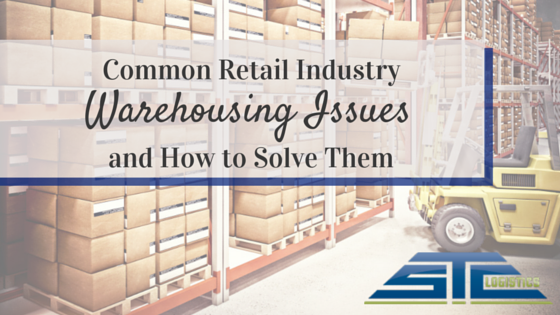
Warehouses are commonly used by retail businesses to store items that have been shipped to them but have not yet been moved into stores. In addition to retailers, transport businesses, manufacturers, customs, importers and exporters use warehouses as well. They may be designed to house goods of a certain type; perishable goods, for instance, are stored in refrigerated warehouses. They may be used to assemble containers for export or prepare consolidated shipments for distributions.
Despite the tremendous value warehouses provide for companies, some issues cannot be avoided altogether. In this article, we will look at some of the most pressing retail warehousing issues and how they may be solved, avoided or minimized.
Top Retail Warehousing Issues
1) Not having enough space
The amount of storage space needed for a company depends on the size and quantity of goods to be stored and length of time which storage is required. Companies aim to rent or purchase warehouses that have enough space to meet their needs, but sometimes end up ordering more merchandise than their space can accommodate or under estimating the length of time necessary. More often, the issue of space occurs as a consequence of inadequate organizational practices, such as not making efficient use of the available space or experiencing delays in implementation of goods at final destinations. Such poor organization leads to time and money being wasted on unnecessary labor and square footage.
To ensure adequate warehouse organization, a company should contract with warehouses and 3pl companies that understand the parameters of retail warehousing requirements. This way, less time will be spent locating items and in turn expedite the actual shipping process, such as using expedited logistics services. The machines used in loading and unloading should also be taken into consideration since they, too, are typically stored on-site. Counter balance machines are not very good for retail warehousing and should be rejected in favor of narrow aisle reach trucks and multi-directional forklifts, which can increase storage space by thirty and forty percent respectively.
Another important element of space management in retail warehousing is to have the place thoroughly evaluated by a professional forklift business. This can further maximize storage space. It is essential to have a facility that understands retail needs and can provide flexibility.
2) Slotting
When looking for slots to store items that have just arrived, forklift trucks often make one trip after another while scouring for space around the warehouse, wasting gas or electricity. As a result, they often end up putting their loads into the first empty slot across which they come, again resulting in disorganization. The last thing that any retail business needs or wants is disorder; they need to know exactly where something is so their customers will not have to wait for inventories to be replenished or for new products to launch.
There are numerous types of storage racks, and good retail warehouse practices involve knowing what they are and the purposes for which they may be used; these include:
- cantilever
- double deep
- drive-in
- powered mobile
Companies can also plan the use of slots, taking into account special needs for certain items as well as supply needs.
3) Discrepancies in inventory, not picking fast enough
Another common warehousing problem occurs when too much time is spent on each item because of poor management practices. When scanned mechanically, barcodes can reduce handling time for merchandise, providing order and ease of access. For larger items and fixture or displays, pallets can be color coded in order to group together specific store configurations or marketing campaigns, thus allowing design teams to have easy access.
In conclusion, retail freight logistics and retail warehousing depends, more than anything else, on organization. With everything in its proper place and employing proper accounting and moving machines, retail warehousing can be vastly simplified, to everyone’s great satisfaction.
STC Logistics specializes in nationwide retail logistics solutions and warehousing services. We ensure not only that your items arrive on time and undamaged with our expedited logistics services, but are stored safely and scheduled with cost-efficiency and reliability. To learn more about our retail freight logistics solutions, click below.
Retail Logistics: Why Timing is Everything
Timing is everything in the retail logistics and transportation industry. Many retail stores struggle to break even in down months and make the entirety of their annual profits in short, frenetic periods each year. Having the right products on the shelves when they are most valuable can mean life or death for any retailer, whether it’s the summer boom in lawn equipment and air conditioners at a hardware shop or having the newest titles on the shelves at a gaming outlet. Ordering too far ahead of schedule can mean as much of a loss as ordering too late—even in periods of low sales, wasted shelves equal lost profits.`
Logistics and transportation must be carefully handled at all stages for a store to achieve maximum profits. On the store’s end, this means careful pre-planning, beginning at least a few months in advance of hectic sales seasons. Important steps in retail planning include:
- Researching products
- Gauging potential sales
- Developing sales and advertising strategies
- Contacting suppliers
- Completing negotiations
- Arranging shipping
- Receiving products and advertising materials
- Shelving products and preparing displays
Several of these steps can be quite difficult without retail logistics and transportation support, but missing important products, over- or under-estimating interest in products or failing to complete negotiations and receive necessary items in a timely manner can all be devastating. Forgetting to order point-of-purchase displays for a major product until the week before the product goes on sale, for example, might make the difference between clear shelves and a full stockroom.
Holidays are of particular concern for any retailer, because as the most vital season for financial success they are also the most likely place for problems to crop up in your logistics and transportation. Perfect preparations store-side can fall apart completely if the chaos of the season overwhelms suppliers, transporters or other parts of your logistics chain. Major logistics and transportation firms fail to deliver express packages on time roughly 10% of the time and lose between 0.5% and 1% of packages every year. Those numbers become even worse during intense seasons.
Having specialists manage your logistics and transportation chain can greatly reduce the odds of delayed order completions and missing shipments. STC Logistics maintains a better than 99% on-time delivery rate to customers in locations across the nation. We offer shipping by air, sea, rail and road and can handle complex large-scale distribution and small daily shipments with equal ease. By working with over 700 logistics and transportation affiliates in and around transportation hubs across the United States, STC Logistics can manage time-sensitive shipments with high precision and reliability. To learn more about our logistics services, click the button below or contact us today for your rate quote!
The Impact of Mobile Technologies on Logistics Solutions
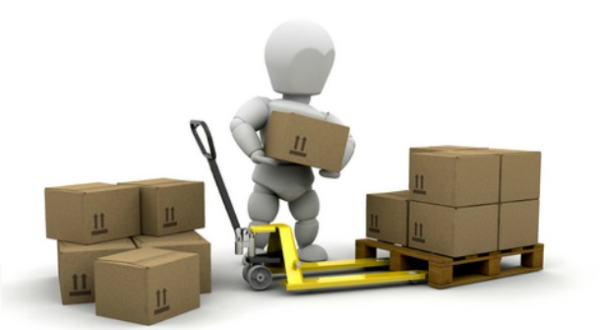 There are many things to consider when hiring a third party logistics company today. While the basics involve utilizing air, land, or sea transportation to move goods from one point to another, there are many intricacies that are added to the process in order to increase efficiency—both for the customer and the logistics company itself. With shifting trends and the notion of new logistics technologies being ever present, there are many concepts that are improving the way freight gets moved.
There are many things to consider when hiring a third party logistics company today. While the basics involve utilizing air, land, or sea transportation to move goods from one point to another, there are many intricacies that are added to the process in order to increase efficiency—both for the customer and the logistics company itself. With shifting trends and the notion of new logistics technologies being ever present, there are many concepts that are improving the way freight gets moved.
Overall, the most revolutionary changes that are happening in logistics technologies today are widely due to advances in mobile logistics technologies. In the past, there were only primitive ruggedized devices that were specifically put into use for supply chain environments. Now, the lines between consumer and commercial grade equipment are becoming blurred because of new logistics technologies. This provides customers, as well as professionals, with crucial solutions to improve processes in every step of the supply chain.
Technology and Logistics in the Warehouse
The utilization of mobile logistics technologies in the warehouse has completely changed the way that companies think about setting up, as well as sorting and segregating inventory. With a single smart phone, warehouse employees are now able to:
- View inventory counts remotely
- Scan inventory both short and long range
- Use voice activated commands to conduct operations hands free
- Send information through the cloud for instant results
- Track and trace transportation itineraries and transit times
Another warehouse trend that cloud-based logistics technologies have set is the use of complete mobile solutions. Because logistics technologies have spider-webbed into so many devices, warehouse teams can now use smart phones and tablets in combination with mobile printers. These scanning devices enable the warehouse workers to reduce the need to move back and forth to different stations in the warehouse. This eliminates issues with sorting, segregating, picking and packing, setting up RFID solutions, scanning barcodes and printing.
For the Customer
Mobile logistics technologies have made the customer end of logistics more productive than ever before. With app development at an all time high, the customer now has more information at their fingertips than ever before. These logistics technologies allow the customer to forgo contacting 3PLs directly in regards to queries such as:
- Inventory quantities
- Price quotes
- Real-time transit status updates
- Delivery times
- Confirmation of POD
Tracking has always been a huge issue for customers until recently because there was little information available without making hard inquiries by phone. But now, trucks, trains, ships, and planes can be outfitted with GPS trackers that the customer can dial into from their smart phone to see exactly where their freight is. This allows them to not only satisfy their curiosity, but plan accordingly based on suggested arrival times.
For the Driver
Utilizing the same type of logistics technologies, truck drivers can now perform many functions with far greater efficiency. Smart phones allow drivers to accurately capture customer signatures upon delivery, track their hours, and even examine statistics about their driving performance. GPS systems can also provide real time data about traffic situations so that they know about areas that should be avoided to achieve shorter transit times.
The Wave of the Future
The smart phone based logistics technologies available today are completely changing the way that everyone thinks about logistics. It is even paving the way for other advances in the future such as 3D printing and greater use of green solutions. For now, 3PLs and customers alike can enjoy the way that mobile logistics technologies has helped to improve the process overall.
STC Logistics utilizes the latest in technology for all logistics solutions. Contact us today to get a quote for your next shipment!
Photo credit: manufacturingdigital.com

